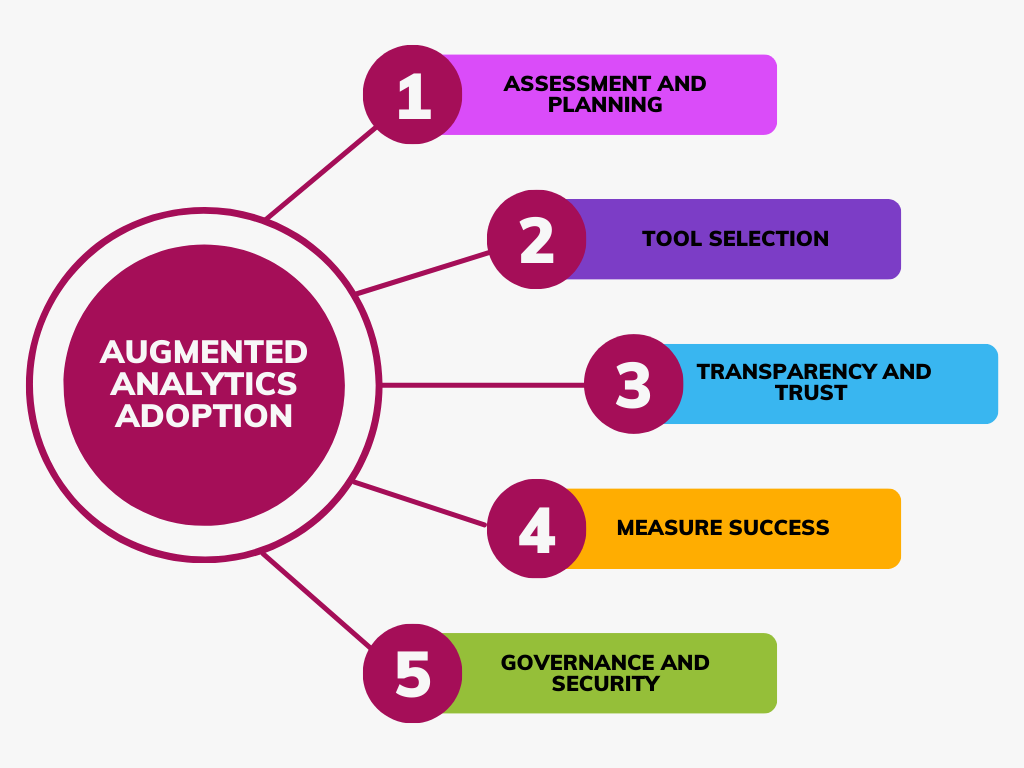Augmented Analytics: Part 2

In part 1, we explored what Augmented Analytics is, the tools that provide it, and how companies are adopting it. We saw that Augmented Analytics is rapidly transforming the traditional analytics lifecycle, automating various aspects and bringing analytics closer to business users.
But do you think it will replace analysts in the future?
While it’s true that Augmented Analytics is making data more accessible to business users, there will be a steep learning curve for fully adopting these automated processes and trusting automated analytics for key decisions. These platforms can often fail to understand a user's intent due to limited context. The numbers generated by a black box might not even align with what the business user is seeking. This mismatch could potentially lead to significant blunders.
Machines can process vast amounts of data, but they often lack the ability to grasp the bigger picture in the same way a person with domain expertise and broader context can. Therefore, the role of analysts remains crucial and will not become redundant. Instead, it will evolve. Analysts will need to adapt their ways of working, viewing Augmented Analytics as a collaborative partner in the data journey. When used correctly, these tools can simplify an analyst’s life considerably.
Analysts will need to upskill to adapt, expanding their expertise to include critical thinking, domain knowledge, and proficiency with advanced analytical tools. Their focus might shift towards more strategic tasks, such as driving innovation within their teams and optimizing processes, while routine data tasks are handled by augmented analytics. This shift provides more space for analysts to grow.
Additionally, analysts will play a vital role in understanding the underlying mechanisms of these tools, ensuring that the models and algorithms used are transparent, fair, and unbiased. This is essential for maintaining accountability and trust in the analytics processes.
Best Practices to Implement and Adopt Augmented Analytics
Adopting augmented analytics requires a strategic approach. Rushing into adoption without careful planning can lead to failure. To help you and your organization successfully implement augmented analytics, let's build a comprehensive framework.

- Assessment and Planning
Evaluate the readiness of your team/organization by assessing the current data infrastructure and team readiness. Address any identified gaps through targeted training, collaboration, and investment. Begin with a small, specific business use case and set clear, measurable objectives for implementation. - Tool Selection
Given the no. of platforms offering augmented analytics, thorough research and careful selection of the right tool are essential. The chosen tool should integrate seamlessly with existing systems and data sources, be user-friendly, easy to adopt, and intuitive. It should also meet your business needs and be scalable to accommodate future growth. - Ensure Transparency and Trust
Analysts should not perceive augmented analytics tools as a black box. It's crucial that the models and algorithms used are understood by the team and can be clearly explained. Conduct ongoing training programs to keep employees updated on new features and best practices. Organize workshops, webinars, and hands-on sessions for business users to help them effectively leverage the tools. Additionally, establish a support system to assist business users with any issues or questions. - Measure Success
Establish key performance indicators (KPIs) to gauge success. Continuously monitor and report on performance against these metrics. Gather feedback from users and stakeholders to inform ongoing improvements to tools and processes. Regularly refine strategies to optimize outcomes based on insights gained. - Governance and Security
It's crucial to prioritize data privacy and compliance with relevant laws and regulations. Certain jurisdictions impose stringent rules, particularly concerning automated data processing and AI usage. *t is important to define clear roles and responsibilities for effective data management and compliance within your organization.
Overall, adopting Augmented Analytics in your organization can give you a competitive edge by enabling faster decision-making through quicker insights from data and by optimizing and streamlining data pipelines.
However, there are certain pitfalls you must avoid during your journey to adopting Augmented Analytics.
Key Challenges in Adopting Augmented Analytics
As with any other technology, adopting augmented analytics presents several challenges that your organization might need to navigate. One significant hurdle is ensuring data quality and integration, as augmented analytics relies heavily on clean, consistent, and comprehensive data from various sources. If the data pipeline is poorly built or if the data is not relevant, it would often lead to inaccurate and non-reliable results. If the datasets are incomplete, the underlying machine learning model might produce data bias and lack context. Addressing biases in the data and models is essential to ensure fair and unbiased decision-making.
Another major challenge is related to performance and scalability. These applications often feed on large datasets. It is important to ensure that your organization's IT system has the computing power to host and scale the data for Augmented Analytics. A poor IT infrastructure can lead to slow response time which in turn will put off employees from adopting Augmented Analytics.
Additionally, there is often resistance to change within organizations, with employees needing time and training to adapt to new tools and processes. It is crucial to promote a data-driven culture and conduct workshops highlighting benefits and different use cases that can lead to faster adoption and greater enthusiasm among employees.
Another major road blocker in the journey of adopting Augmented Analytics is maintaining data privacy and security. It is important to check if the data used isn't breaking any regulations or compliance policies.
Final Thoughts 💭
In conclusion, while the journey to adopting Augmented Analytics may present various challenges, the benefits it offers in terms of enhanced decision-making, efficiency, and innovation make it a worthwhile endeavour. By carefully planning, ensuring data quality, fostering a data-driven culture, and addressing security concerns, organizations can successfully integrate Augmented Analytics into their workflows. As technology continues to evolve, staying ahead with Augmented Analytics can provide your organization with a significant competitive edge, enabling them to harness the full potential of their data for strategic growth and success.
References:



%20(1).png)




